 |
 |
 |
http://www.varalaaru.com A Monthly Web Magazine for South Asian History [187 Issues] [1839 Articles] |
 |
 |
 |
http://www.varalaaru.com A Monthly Web Magazine for South Asian History [187 Issues] [1839 Articles] |
|
Issue No. 122
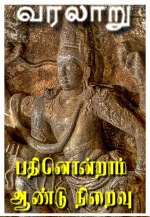
இதழ் 122 [ ஆகஸ்ட் 2015 ] பதினொன்றாம் ஆண்டு நிறைவு மலர் 
இந்த இதழில்.. In this Issue.. 
|
Sculptures The sculptures of Thirunedungalanathar temple can be classified into early and later periods. Dvarapalas of the second gopura and of the mukha mandapa, Dakshinamurthy, Saptamathas, Vishnu and his consorts in the thiruchurru belong to Chola period. Kala Bhairava, Bhairava, Surya, Chandra, Jyeshta, Ammaiyappar, Subrahmanya belong to later period. 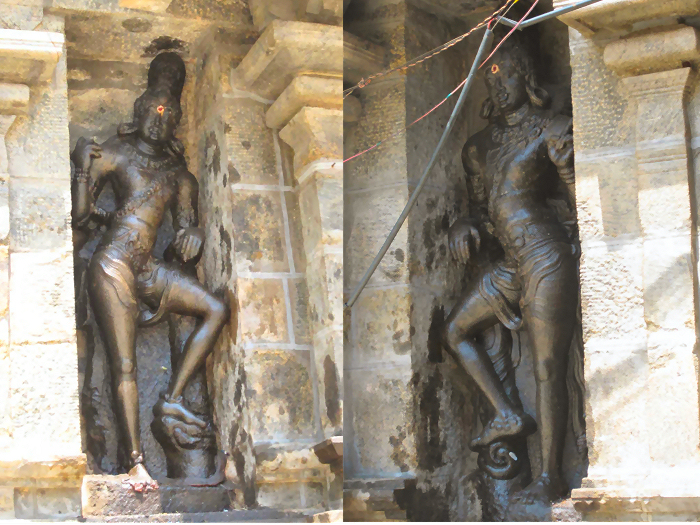 Dvarapalas Dvarapalas at the Second Gopura Both the Dvarapalas are standing on a pedestal with their outer leg in sama and their inner leg lifted up and placed in parsva on the knot of the branch. Their outer hand is in a mudra whereas their inner hand rested on the plank. The left hand of the southern dvarapala is in vismaya whereas the right hand for his counterpart is in tarjani. Both are adorned with short attire (kut[hp Mil) as lower garment and idaikattu above it. The lower garment is fastened by a hip belt which possesses simha clasps ( சிம்மமுக அரைப்பட்டிகை ). The idaikattu is slackly worn above the lower garment which is knotted on both the sides and the tassels hang upto the ankle. Yajnopavita is flower patterned worn in niveta fashion while for the northern Dvarapala double string is shown entwined. Both the Dvarapalas are richly adorned with ornaments. Bangles, keyura (armlets), tharagaichummai (hip ornament), charapali, a long pendant, patrakundala, owl kundala, finger rings, udarabandha, anklets. The anklet of the southern Dvarapala is of heavy beads whereas of his counterpart is wearing salangai. The locks are arranged as jatamakuta with kirtimukha in the centre and also adorned with head band. Besides, untied locks also spread on the shoulders. Both are shown with tusks. Their eyes are spewed out and mouth slightly open exhibiting the tusks. Both the Dvarapalas are best examples of Early Chola sculptures, demonstrating the mastery of the Chola sculptors. Both are tall, slender but majestic and their slight inclination towards the sanctum adds grace to their look. The anatomy is quite natural and their posture is imposing. Their spewed out eyes and tusks are not intimidation instead exhibiting the stateliness. 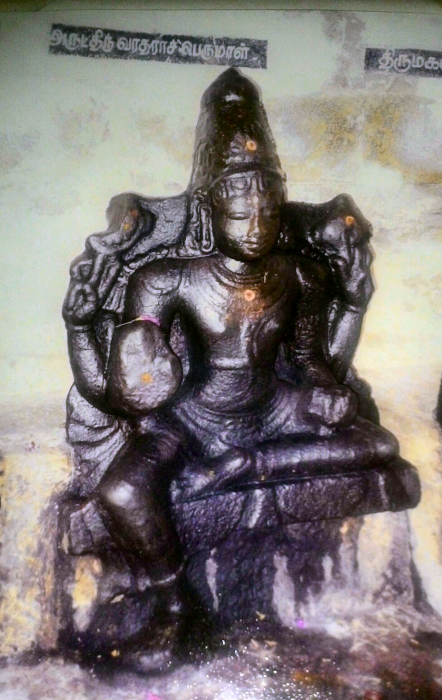 Vishnu Vishnu with his Consorts Vishnu and his consorts Sridevi and Bhudevi are among the early sculptures in the temple complex. Once they were under worship in Varadaraja Perumal shrine but at present kept on the western prakara replaced by new sculptures. Vishnu is seated in suhasana on a pitha with his left leg folded flat on the pitha and his right leg stretching down. His front hands are in abhaya and varada and back hands in kartari hasta carry sankha and chakra. He is adorned with silk dress extending upto the ankle and idaikattu slackly worn above it. Kankanas, keyura, bahuvalai, charapali, chavadi, makara kundalas are the ornaments adorn by him. Skandamala adorns the shoulders. Yajnopavita is worn in upavita fashion. Kirita makuta adorn his head. Both the Goddesses are seated in utkutikasana on the pitha with their outer leg folded upright and inner leg dangling down. Both are adorned with karanda makuta, patrakundalas, charapali, kankanas and keyuras. Both the Goddesses are adorned with attire extending upto their ankle and a band around their breast. 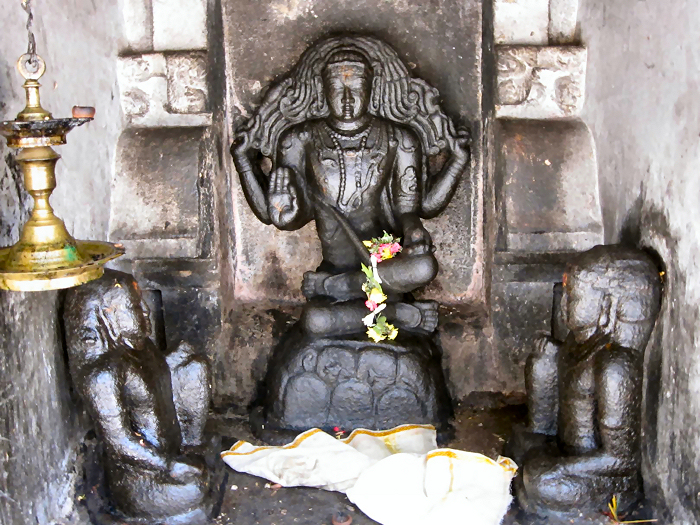 Dakshinamurthi Dakshinamurthi Dakshinamurthi is seated on a hillock in rajalingasana with his left leg placed above the right leg. His front right hand is in chin mudra and the front left hand is placed on the thigh in kataka and also carries fire. The back hands are in kartari hasta and carry axe in the right and deer in the left. His locks are arranged as jatabhara in which the braids are curled at the tips and adorned with crescent moon on the left and a flower on the right. Chavadi, beaded mala, baguvalai, kankanas, keyura, udarabandha, talseri (anklet) are the ornaments adorn by him. Yajnopavita is worn in upavita fashion and the brahma knot formed above the chest. The yogapatta is worn encircling his left leg. Animals like snake, ox and deer are shown on the hillock as listening to the God. Besides, two of the sages are shown seated in front of the God. 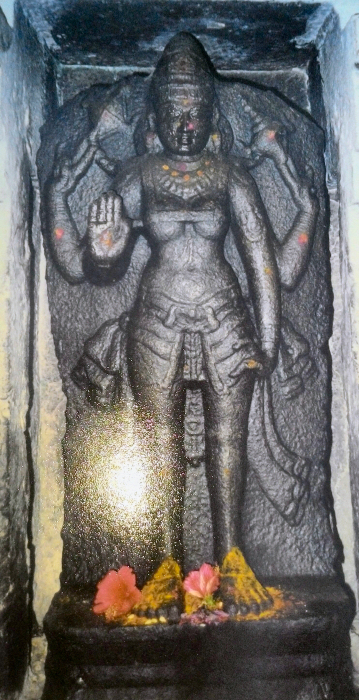 Durga Durga The Goddess is standing in sama with her front right hand in abhaya and the front left hand in katyavalambita. The back hands are in kartari hasta and also carry prayoga chakra in the right and sankha in the left. She is adorned with short attire, idaikattu and breast band. Karanda makuta adorn her head and siraschakra is shown behind. Patrakundalas, kankanas, keyuras, kantika, charapali are the ornaments adorn by her. Kala Bhairava Kala Bhairava is in relief form standing in sama on a pitha. The God is nude, a snake shown wound around his waist. His front hands carrying sula and skull bowl and the back hands are carrying damru and snake. His locks are arranged as sudarmudi. Makara kundalas, snake keyura are the ornaments adorn by him. Snakes are shown entwining his both legs. Surya and Chandra Both the luminaries are standing in sama in a pitha carrying lotus in both the hands while Surya bloomed flowers, Chandra buds. Both are adorned with karanda makuta, patrakundalas, kankanas, keyuras, short attire and idaikattu. Yajnopavita is worn in upavita fashion. A halo is shown behind their head. Saptamathas Among the two sets of Saptamatha groups placed on the southern thiruchurru the one sculpted as separate icons are the early sculptures. The Goddesses are placed in the order viz., Brahmi, Maheswari, Kaumari, Vaishnavi, Varahi, Indrani and Chamundi. The goddesses are flanked by Veerabadra and Ganesa. All the deities are seated on a pedestal. 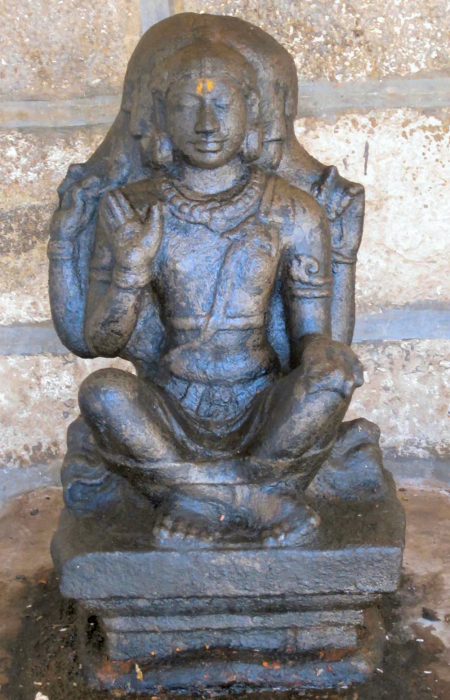 Veerabadra Lord Siva in the form of Veerabadra is seated in yogasana with yogapatta. His lower garment is short attire and idaikkattu is slackly worn above it. Heavy knots of the idaikattu spread on both sides on the pedestal. Vastra yajnopavita is worn in upavita fashion and the brahma knot is shown above the chest. His front hands are in poses; the right is in abhaya hasta and the left hand is in kataka mudra with palm facing up. The back hands are in kataka and also carry fire in the right and akshamala in the left. His locks are beautifully arranged as jatabhara gathered as a bunch in the back head. The hair dressing is further ornamented with head band and a flower. The ears are adorned with patrakundalas, kankanas and keyuras in the arms, stone studded udarabandha in abdomen and charapali around neck are the other ornaments adorn by him. 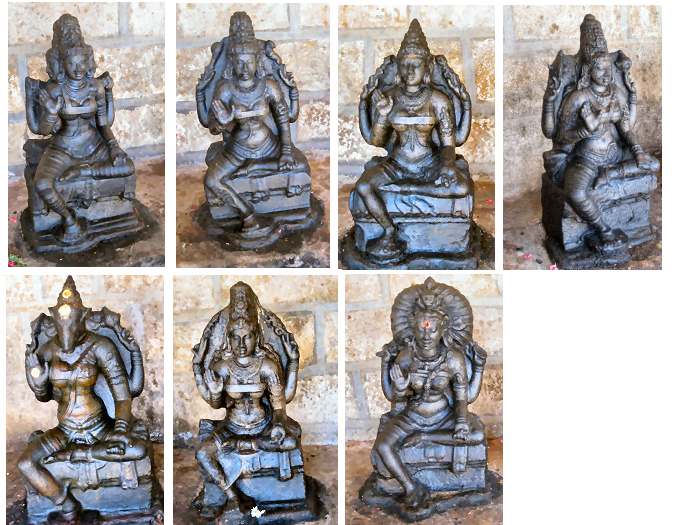 Saptamatas All the Goddesses are seated in suhasana with their right leg folded flat on the pitha and their left leg dangling down and rested on the foot rest. The foot rest is a circular projection formed out of the pitha. Their front right hand is in abhaya hasta and their front left hand is placed on the left leg in kataka mudra with palm facing up. Their back hands carry their respective weapons and also in a mudra; except Brahmi and Chamundi the rest of the Goddesses are in kartari hasta whereas they are in kataka mudra. Brahmi is carrying akshmala in the right and kamandalu in the left. Maheswari axe in the right hand and deer in the left, Kaumari and Indrani sakti in the right and vajra in the left, Vaishnavi and Varahi prayoga chakra in the right and sankha in the left, Chanmundi small knife in the right and scull bowl in the left. The Goddesses are gorgeous, richly decked with ornaments, attire and hair dressing. The locks of the Goddesses are arranged in various styles. The braids of Brahmi and Maheswari are formed as jatamakuta in the apex. Kaumari and Varahi are adorned with karanda makuta comparing the one of the latter the former’s is heavy. Vaishnavi and Indrani are adorned with kirita makuta, both are equally ornamental. The locks of Chamundi is styled as virisadai. In addition the hair dressing is further ornamented with a heavy stone studded disc along the makuta and a head band in the forehead. Kaumari is adorned with chenni. Siraschakra is shown for Kaumari, Vaishnavi and Indrani. Few of the locks of Indrani are left untied and spread floating behind which is decked with flowers. As like, for Varahi the overflowing locks from the makuta are formed as loops. The hair dressing of Chamundi is different from all and also interesting to note. Thick braided locks are gathered in the back head knotted with a girdle which form a bow knot in the left side of the head. The gathered locks spread like a circle behind the head and at the apex a skull pendent is shown hanging in the middle flanked by snakes. The snakes also entwine the gathered locks as a girdle. The Goddess is also adorned with flowers, bloomed one on the right side of the head and buds in the locks. Brahmi, Vaishnavi, Varahi and Indrani are adorned with dress draping upto the ankle. While for the former two deities it is well creased denoting silk wear whereas for the other two of the deities it is plain, can be a diaphanous wear. Maheswari, Kaumari and Chamundi are adorned with short attire draping the thigh. Their lower garment is fastened by hip belt, the excess girdle flows in the front for Kaumari and Chamundi. All the Goddesses are adorned with idaikattu which is slackly worn above the lower garment. Heavy knots of the idaikattu spread on the sides and the tussles flow in the front. Except Chamundi all the Goddesses are adorned with breast band which also has shoulder straps. For Chamundi a snake is shown entwine above the breast. Except Kaumari and Indrani all the Goddesses are adorned with yajnopavita as the other two are adorned with chhannavira, symbol of valour. Vaishnavi is wearing in niveta fashion while all the others are in upavita fashion. Vaishnavi and Varahi are adorned with vastara yajnopavita and worn above the breast band. The brahmasudra of the yajnopavita is shown above the breast. The yajnopavita of Chamundi is a garland of human head hooked on an entwined double string. It’s a very rare example usually skull garland is shown. The chhannavira is ornamental for Kaumari comparing with that of Indrani. Ears are elongated and adorned with kundalas; Brahmi, Maheswari, Vaishnavi and Indrani are decked with makarakundalas on both ears while Kaumari is adorned with patrakundalas and Chamundi with patrakundala in the left and a human being in the right. In addition Maheswari is also adorned with a stud (brtpg;g{). Charapali, kankana, keyura (armlets), talseri (anklet), megalai (hip ornament), rings are the other ornaments of the deities. For some of the deities the keyura is coiled and for some single ringlet with an ornamental disc. Chamundi is adorned with a snake as anklet. Charapali is also of different types; some are stone studded and some are self designed. Chamundi and Vaishnavi are adorned with heavy necklace with stones studded in the center. In addition with charapali Brahmi, Maheswari and Kaumari are adorned with pearl mala, chavadi by Indrani. Among the goddesses Brahmi is in wide smile in all her faces, Indrani and Vaishnavi are in slight grin, Chamundi, with spewed out eyes, mouth wide open, tusks conspicuous and the crude accessories a picture perfect of intimidation. Ganesa is seated in maharajalilasana with his back hands carrying pasa and angusa and the front right hand is in kataka and carry tusk whereas the left hand carry the motaka. He is adorned with karandamakuta, charapali, udarabanda and bangles. His proboscis is left turned and enjoys the motaka carried on the left front hand. The Saptamatha group is a splendid portrayal, the deities in their perfect stature decked with rich ornaments, attire and hair dressing all shows them imposing. The arresting nature of the sculptures will never fail art lovers to appreciate it. It’s another example in the temple exhibiting the mastery of Chola artists. Dvarapalas in the Shrine Entrance Both the dvarapalas are standing facing straight but their lower body is twisted towards the sanctum. Their inner leg placed on the pitha whereas their outer leg lifted up and placed on the weapon held by them. The Dvarapala in the south placed his left hand on the axe and the right hand in tarjani whereas his counterpart is showing vismaya in the right and the left hand is placed on the wooden plank. Their locks are formed as braids and arranged as jatamakuta and decked with forehead band. Both the dvarapalas are richly adorned with ornaments like kantika, charapali, beaded necklace around the neck, kankana and kirtimukha keyura in the arms, udarabandha in the abdomen, talseri in the ankles. The ears are elongated lobes and adorned with patrakundalas by the southern Dvarapala whereas his counterpart by owl kundalas. Both are wearing short dress as lower garment and secured by hip belt and idaikattu is slackly worn above it. Yajnopavita is work in upavita fashion. Tusks are shown for both. Jeyshta Jeyshta flanked by her son and daughter is formed as a bas-relief panel. All the three are seated on a pitha in which her son is to her right and daughter to her left. Jeyshta is adorned with karanda makuta, silk dress and chhannavira. The ornaments adorn by her are patra kundalas, bangles, armlets and anklets. Her right hand is in abhaya and the left hand rests on her thigh. Her son Nandikeswara in shot attire adorned with bangles and armlets, is holding a stick in the right hand and the left hand is rested on his thigh. Her daughter Agnimatha is adorned with karanda makuta and short attire, is carrying a lotus bud in the right hand and her left hand is rested on the pitha. Patrakundalas, bangles and armlets are the ornaments adorn by her. A lamp is shown in between Jeyshta and Agnimatha and the insignia crow on a post is shown in between the son and the mother. 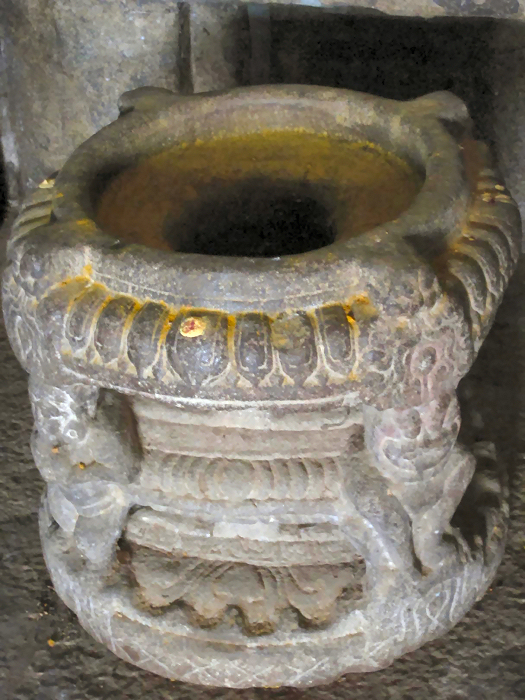 Pestle Pestle Grinding turmeric to the deity is one of the prayer offering in the temple. For this an ornamental pestle is seen in the maha mandapa. The pestle is decorated with padma petals in the top and the bottom and vrtta kumuda in the middle. The kumuda is flanked by kantha features. A gana, a female, a squatting lion and a squatting yazhi are shown on the four sides and kirtimukhas are shown above these figures. The flows from the mouth of the simhas are formed as arches in the upper padma series. Courtesy: My sincere thanks to Dr.R.Kalaikkovan, Director, Dr.M.Rajamanikkanar Institute of Historic Research for his guidance and for providing all the photos featured in this article. |

சிறப்பிதழ்கள் Special Issues 

புகைப்படத் தொகுப்பு Photo Gallery 
|
| (C) 2004, varalaaru.com. All articles are copyrighted to respective authors. Unauthorized reproduction of any article, image or audio/video contents published here, without the prior approval of the authors or varalaaru.com are strictly prohibited. | ||